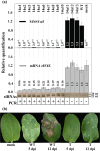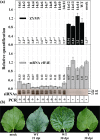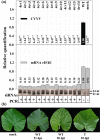Melon RNA interference (RNAi) lines silenced for Cm-eIF4E show broad virus resistance
- PMID: 22309030
- PMCID: PMC6638723
- DOI: 10.1111/j.1364-3703.2012.00785.x
Melon RNA interference (RNAi) lines silenced for Cm-eIF4E show broad virus resistance
Abstract
Efficient and sustainable control of plant viruses may be achieved using genetically resistant crop varieties, although resistance genes are not always available for each pathogen; in this regard, the identification of new genes that are able to confer broad-spectrum and durable resistance is highly desirable. Recently, the cloning and characterization of recessive resistance genes from different plant species has pointed towards eukaryotic translation initiation factors (eIF) of the 4E family as factors required for the multiplication of many different viruses. Thus, we hypothesized that eIF4E may control the susceptibility of melon (Cucumis melo L.) to a broad range of viruses. To test this hypothesis, Cm-eIF4E knockdown melon plants were generated by the transformation of explants with a construct that was designed to induce the silencing of this gene, and the plants from T2 generations were genetically and phenotypically characterized. In transformed plants, Cm-eIF4E was specifically silenced, as identified by the decreased accumulation of Cm-eIF4E mRNA and the appearance of small interfering RNAs derived from the transgene, whereas the Cm-eIF(iso)4E mRNA levels remained unaffected. We challenged these transgenic melon plants with eight agronomically important melon-infecting viruses, and identified that they were resistant to Cucumber vein yellowing virus (CVYV), Melon necrotic spot virus (MNSV), Moroccan watermelon mosaic virus (MWMV) and Zucchini yellow mosaic virus (ZYMV), indicating that Cm-eIF4E controls melon susceptibility to these four viruses. Therefore, Cm-eIF4E is an efficient target for the identification of new resistance alleles able to confer broad-spectrum virus resistance in melon.
© 2012 THE AUTHORS. MOLECULAR PLANT PATHOLOGY © 2012 BSPP AND BLACKWELL PUBLISHING LTD.
Figures





Similar articles
-
An eIF4E allele confers resistance to an uncapped and non-polyadenylated RNA virus in melon.Plant J. 2006 Nov;48(3):452-62. doi: 10.1111/j.1365-313X.2006.02885.x. Epub 2006 Oct 5. Plant J. 2006. PMID: 17026540
-
EcoTILLING for the identification of allelic variants of melon eIF4E, a factor that controls virus susceptibility.BMC Plant Biol. 2007 Jun 21;7:34. doi: 10.1186/1471-2229-7-34. BMC Plant Biol. 2007. PMID: 17584936 Free PMC article.
-
Editing melon eIF4E associates with virus resistance and male sterility.Plant Biotechnol J. 2022 Oct;20(10):2006-2022. doi: 10.1111/pbi.13885. Epub 2022 Jul 25. Plant Biotechnol J. 2022. PMID: 35778883 Free PMC article.
-
Eukaryotic translation initiation factor 4E-mediated recessive resistance to plant viruses and its utility in crop improvement.Mol Plant Pathol. 2012 Sep;13(7):795-803. doi: 10.1111/j.1364-3703.2012.00791.x. Epub 2012 Mar 2. Mol Plant Pathol. 2012. PMID: 22379950 Free PMC article. Review.
-
eIF4E Resistance: Natural Variation Should Guide Gene Editing.Trends Plant Sci. 2017 May;22(5):411-419. doi: 10.1016/j.tplants.2017.01.008. Epub 2017 Feb 28. Trends Plant Sci. 2017. PMID: 28258958 Review.
Cited by
-
Different RNA Elements Control Viral Protein Synthesis in Polerovirus Isolates Evolved in Separate Geographical Regions.Int J Mol Sci. 2022 Oct 19;23(20):12503. doi: 10.3390/ijms232012503. Int J Mol Sci. 2022. PMID: 36293360 Free PMC article.
-
Structural and Functional Diversity of Plant Virus 3'-Cap-Independent Translation Enhancers (3'-CITEs).Front Plant Sci. 2017 Nov 29;8:2047. doi: 10.3389/fpls.2017.02047. eCollection 2017. Front Plant Sci. 2017. PMID: 29238357 Free PMC article. Review.
-
Candidate genes for field resistance to cassava brown streak disease revealed through the analysis of multiple data sources.Front Plant Sci. 2023 Nov 3;14:1270963. doi: 10.3389/fpls.2023.1270963. eCollection 2023. Front Plant Sci. 2023. PMID: 38023930 Free PMC article.
-
RNA interference and crop protection against biotic stresses.Physiol Mol Biol Plants. 2021 Oct;27(10):2357-2377. doi: 10.1007/s12298-021-01064-5. Epub 2021 Sep 22. Physiol Mol Biol Plants. 2021. PMID: 34744371 Free PMC article. Review.
-
Current Advancements and Limitations of Gene Editing in Orphan Crops.Front Plant Sci. 2021 Sep 22;12:742932. doi: 10.3389/fpls.2021.742932. eCollection 2021. Front Plant Sci. 2021. PMID: 34630494 Free PMC article. Review.
References
-
- Abou‐Jawdah, Y. , Sobh, H. , Fayad, A. , Lecoq, H. , Delécolle, B. and Trad‐Ferré, J. (2000) Cucurbit yellow stunting disorder virus—a new threat to cucurbits in Lebanon. J. Plant Pathol. 82, 55–60.
-
- Bananej, K. and Vahdat, A. (2008) Identification, distribution and incidence of viruses in field‐grown cucurbit crops of Iran. Phytopathol. Medit. 47, 247–257.
-
- Browning, K.S. (1996) The plant translational apparatus. Plant Mol. Biol. 32, 107–144. - PubMed
-
- Browning, K.S. (2004) Plant translation initiation factors: it is not easy to be green. Biochem. Soc. Trans. 32, 589–591. - PubMed
-
- Clepet, C. , Joobeur, T. , Zheng, Y. , Jublot, D. , Huang, M. , Truniger, V. , Boualem, A. , Hernandez‐Gonzalez, M. , Dolcet‐Sanjuan, R. , Portnoy, V. , Mascarell‐Creus, A. , Cano‐Delgado, A. , Katzir, N. , Bendahmane, A. , Giovannoni, J. , Aranda, M. , Garcia‐Mas, J. and Fei, Z. (2011) Analysis of expressed sequence tags generated from full‐length enriched cDNA libraries of melon. BMC Genomics, 12, 252. - PMC - PubMed
Publication types
MeSH terms
Substances
LinkOut - more resources
Full Text Sources
Other Literature Sources

